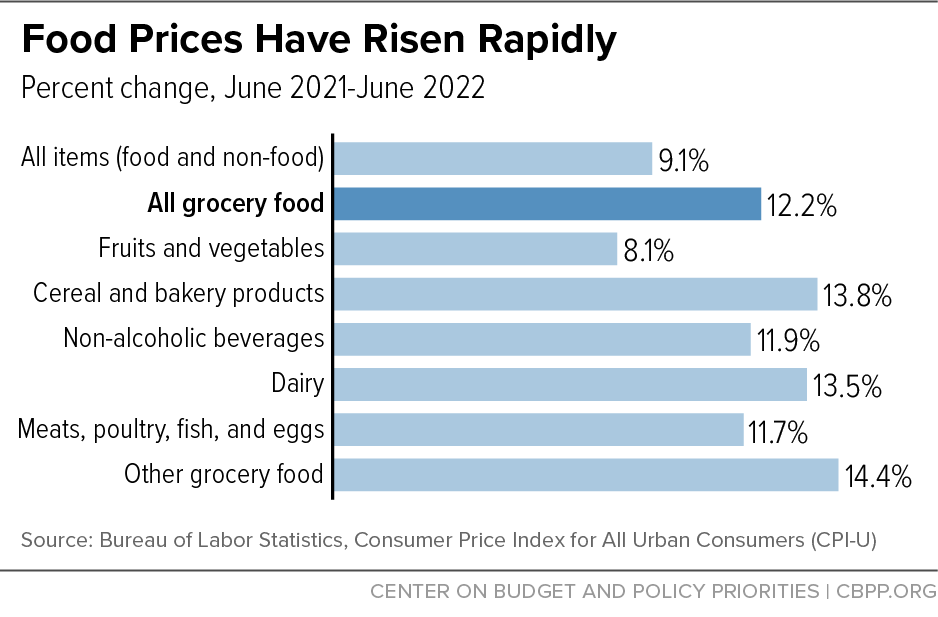BEYOND THE NUMBERS
SNAP Benefit Adjustments Will Help Low-Income Households Cope With Food Inflation
On October 1, 2022, Supplemental Nutrition Assistance Program (SNAP) benefit levels will automatically rise to reflect changes in the cost of living, helping households with low incomes cover their food needs and countering recent high food inflation.
Food budgets have been stretched thin in recent months due to rapidly increasing prices for groceries and other necessities. Prices for groceries (food to be prepared or eaten at home) rose 12.2 percent for the 12 months ending June 2022 (see graphic). That’s the largest 12-month increase since April 1979. SNAP maximum benefits, which are tied to food inflation, will increase by a similar percentage (12.5 percent) at the start of the next federal fiscal year in October.
The SNAP benefit update is based on food inflation for the 12 months ending in June 2022. The inflation report for July shows that inflation moderated in July, but prices for grocery food were up by 13.1 percent compared to July 2021. (Adjustment of SNAP benefits for inflation differs slightly from overall inflation for groceries for the same time period because the basis of the benefit is weighted more heavily toward certain foods, such as fruits and vegetables, whole grains, and dairy.)
SNAP’s purpose is to increase low-income households’ purchasing power so they can afford a more nutritious diet. SNAP benefit levels are based on the cost of the Thrifty Food Plan (TFP), a set of foods that represent a nutritionally adequate diet that low-income households can purchase and prepare, assuming they take significant steps to stretch their food budget.
To ensure that SNAP benefits keep pace with the cost of food and other expenses, SNAP automatically adjusts benefit levels each October 1. The maximum SNAP benefit levels are equal to the cost of the TFP from the preceding June scaled to household size. The cost of the TFP in June 2022, which will be the basis for fiscal year 2023 SNAP benefits, was $939.90 per month for the reference family of four, defined by law as a man and a woman aged 20 to 50, a child 6 to 8 years old, and a child 9 to 11 years old.
The Department of Agriculture (USDA) also makes other annual program adjustments to account for inflation. In addition to the October 1 increase to maximum benefits, USDA announced this week increases to reflect inflation in the program’s income limits, standard deduction, cap on excess shelter deduction, homeless shelter deduction, minimum benefit level, and asset limits.
Without these changes, the value of SNAP benefits would erode over time; these adjustments ensure that households retain purchasing power. Cost-of-living adjustments are not unique to SNAP. For example, school meal reimbursement rates, income thresholds for Medicaid, and Social Security benefits are adjusted annually to account for inflation.
In fact, rapid food price inflation has eroded the purchasing power of SNAP benefits over the last year. Maximum SNAP benefits for a household of four in June 2022 — set in October 2021 and based on the cost of the TFP in June 2021 — were $835, or more than $100 less than cost of the foods in the Thrifty Food Plan that month. When inflation erodes the value of SNAP benefits during the year, households either have to spend more of their cash income on food or cut back on their food expenditures.
USDA has found that food insecurity increases with rising inflation. There are signs that food hardship has been rising over the past year, coinciding with high inflation and the end of many federal pandemic relief measures. Temporary emergency SNAP benefits, which Congress and the Trump Administration first authorized in March 2020, have helped cushion the blow of income loss and inflation during the pandemic. All states issued emergency benefits for the first year of the pandemic, but many (16 states as of July 2022) no longer provide them. The SNAP emergency benefits will end when the national public health emergency ends.
While high inflation rates are leading to larger cost-of-living adjustments this year, in most years the annual adjustments to SNAP benefits are small because food inflation is typically low. (In the two decades before the COVID-19 pandemic, annual food inflation averaged about 2 percent per year.)
Separate from the annual inflation adjustments, Congress in the bipartisan 2018 farm bill directed USDA to update the TFP to more accurately reflect the cost of a healthy diet. USDA completed this science-driven reevaluation in August 2021, resulting in a 21 percent increase in maximum SNAP benefits that took effect in October 2021.
While SNAP benefits have been automatically adjusted each year for food inflation, their purchasing power had not been adjusted since the 1970s for other changes, such evolving dietary recommendations and changes to the economic realities most struggling households face when trying to buy and prepare healthy foods. A large body of research found that, prior to the 2021 TFP revision, SNAP benefits fell well short of what households needed to ensure a healthy diet; many households ran out of benefits before month’s end, which increased their risk of food insecurity.
As we have written, the increase in SNAP benefits resulting from last year’s TFP revision will help households better afford a healthy diet and reduce their risk of food insecurity and poverty. The October adjustment to SNAP benefits will also mitigate rising food hardship and help households regain some of the purchasing power that they’ve lost due to rapidly rising food prices.

